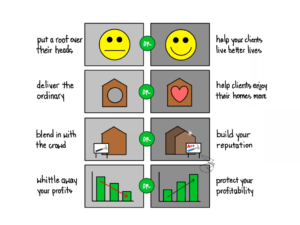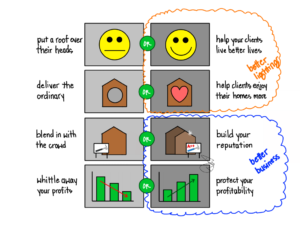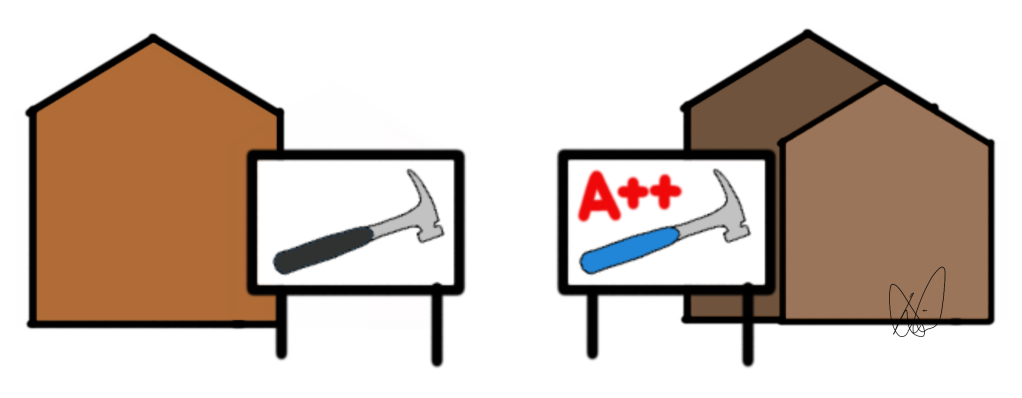Lighting designers and builders often complain about each other…instead of partnering for the benefit of all.
Custom residential lighting design – the way it is normally done – can be the enemy of a builder’s desire to complete the project on time and on budget. Great lighting requires more planning (adding cost and time), better fixtures (adding cost and time), more of those fixtures (adding cost and time), and more complicated installs (adding cost and time). We can make a strong case for proceeding despite these realities, at least on the very bespoke custom homes where quality is more important than budget or timeline.
But what about the rest of the homes? Do lighting designers just sit around and blame builders for fighting against our efforts? Or do we consider the builder’s needs and redevelop our services to suit? In other words, is it fair to blame builders for limiting lighting on their projects without giving them an option that actually works for them?
I don’t think so. I think we must examine our own practices and rethink how we do light if we want to support the industrious builders who construct most of the homes on the planet.
“But that would mean compromise, and as a professional lighting designer, I won’t compromise on the quality of a design.”
Great. Stick to that when you are designing with an unlimited budget and timeline. I am not trying to change the top end of lighting design; I am arguing that we need to change so we can serve the rest of the people. Compromises may hurt the ultimate lighting designs, but they are the only way to deliver better lighting for most projects.

Getting better lighting in homes requires making different choices, and making different choices means understanding the options. I tend to oversimplify the processes of lighting design intentionally, in an ongoing effort to make what is too often highly complicated accessible to more. So please accept my apologies for the right/wrong dichotomy here: most choices are shades of gray. But even amid shades of gray, builders make choices with lighting that will decidedly impact the outcomes. Here are four such choices:
Put a roof over their heads…or help your clients live better lives.
My first job out of college was essentially as a general contractor building homes, but I moved into lighting long before I became a good builder. Now our team works with builders across the country and across a wide spectrum of capabilities, but every single one of them can build a house better than any lighting designer I know. That does not seem to stop me and other lighting designers from telling builders how to do their job…which is not exactly a collaborative or productive attitude.
But it doesn’t make me always wrong, either. There is- as this entire blog strives to share- a difference between the way lighting is typically done in our homes and the way it should be. So builders are faced with a choice: will they build houses that check the boxes and put a roof up, or will they choose to pursue better lighting that can help their clients live better lives? Yes, better lighting can help clients wake gently, move with greater ease, relax more easily, and rest deeply. But not the way we are doing it now.
Deliver the expected…or help clients enjoy their homes more.
We are among the lucky few that get to hear from clients amazed by how lighting helps transform their homes into oases from the noises and stresses of everyday life. Lighting, when done well, makes a difference in how people use and appreciate their homes.
Builders that choose better lighting end up building homes with more satisfied clients, which can be good for business…unless the lighting design process pushes them over budget and delays delivery past the due date. Then it might be a toss-up, and who wants to gamble with their business?
Blend in with the crowd…or build your reputation.
There may not be enough homebuilders in the United States (or in the world), but that does not mean there is no competition among them. I see some pretty wonderful websites and beautiful marketing materials used by builders to win over clients, but perhaps the most important marketing tool is the homes themselves.
I have yet to visit a builder’s website that features photographs of their homes after sunset, when it will most likely be most used by the homeowners. Why? The biggest reason is that those photographs won’t look as appealing to prospective clients, because the lighting just isn’t very good. It is notoriously difficult to photograph homes at night, and bad lighting just makes it all worse. So photographers bring in their own lights to brighten up and even out the space, but those photographs tell us very little about how the space feels.
Builders interested in building their reputation can use lighting to differentiate themselves from the crowd. This can be a good case for hiring a lighting designer, but a good reputation is about more than just pretty pictures. Builders are also judged on their business practices and how well they stay on budget and and on time.
Whittle away your profits…or protect your profitability.
Great lighting costs more money and takes more time. Period. So how can builders offer better results to their clients without threatening their business? I think the answer, as hinted above, lies in compromise. We lighting designers can do incredible things with light. But if we only deliver at the highest level, we limit the ability of most builders and homeowners to achieve even a little bit better results.
A builder who recommends lighting designers, without careful planning, may end up hurting their business. Great lighting won’t be easy or cheap or fast. So what is the alternative? Is there a way for a builder to deliver great lighting and even increase profitability? Sure. But you have to do a little work to get there.

Here’s an ugly realization I had while thinking about this post. The top two choices will get better lighting, but it is the bottom two choices that determine whether or not a builder will ultimately be successful. As a lighting designer, our value is almost always found in the first two. If we want to change the world, we have to figure out how to help builders on the bottom half of the chart.

Here’s how I see it: if a builder is satisfied with simply providing shelter, merely meeting client expectations, blending in with the competition, and protecting their bottom line, they should not change they way they approach lighting. Stay the course.
If a builder is interested in providing a better life for their customers and building more beautiful homes that stand out, they should recommend lighting designers…and brace for the negative impacts on budget and time.
For the few builders that are interested in providing a better experience for their clients every single night, but also interested in protecting their reputation as a cost-effective and on-time builder, they might benefit from considering a third way: partnering with an open-minded lighting designer or team.
I have a few new thoughts on the shape of such partnerships and will share them in my next post. And I am excited about the potential of collaborating with builders to move everything to the right side. Sure, it will help all our businesses thrive. But more importantly, we will truly be making a positive difference in the lives of more people.
And that puts a smile on my light bulb.
